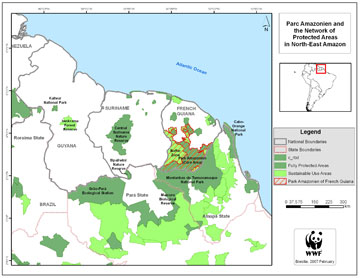New park in French Guiana creates largest Amazon protected area
New park in French Guiana creates largest Amazon protected area
Rhett A. Butler, mongabay.com
February 28, 2007
Environmental group WWF has applauded the creation of a new national park in French Guiana, a department of France located in northeastern South America.
WWF says the 2 million-hectare Guyana Amazonian Park will link to protected areas in neighboring Brazil, including the Tumucumaque National Park, Grao-Para Station and Maicuru Reserve. In total, the protected areas network will encompass 12 million hectares of tropical forest, making it the world’s largest rainforest park.
“We have been supporting the creation of this park for the past 15 years, so we can only be pleased by such an outcome,” said Serge Orru, CEO of WWF-France. “The protection of such a large cover of tropical forest will also help reduce deforestation, which significantly contributes to climate change worldwide.”
 Click to enlarge. Courtesy of WWF |
While the environmental groups is pleased with the establishment of the park, it is concerned about development in the buffer zone as well as threats to native populations living outside the reserve. In recent years, informal gold-mining has surged in the border region as miners known as garimpeiros illegally cross over from Brazil.
“The creation of the new park is a strong commitment for the long-term conservation of French Guiana’s forests,” said Laurent Kelle, Head of WWF’s office in French Guiana. “But given the current situation in the field, only a serious and effective cooperation with Brazil and Suriname will help tackle illegal gold mining, and lead to responsible management of the whole complex of protected areas in region.”
Related Articles
Europe’s largest tropical rainforest invaded by gold miners — 12/19/2006
As Europe frets over climate change and deforestation, threats to “Europe’s largest tropical rainforest” are mounting, according to reports from French Guiana. While French Guiana is best known for its infamous Devil’s Island penal colony and as the main launch site for the European Space Agency, which is responsible for more than 50% of the state’s economy activity, most of the territory is covered with lowland tropical rainforest. French Guiana’s forests are biologically rich with some 1,064 known species of amphibians, birds, mammals and reptiles, and 5,625 species of vascular plants according to figures from the World Conservation Monitoring Center.
Time is running out for French Guiana’s rainforests — 12/19/2006
Understanding relationships between plants and animals is key to understanding rainforest ecology. Dr. Pierre-Michel Forget of the Museum National d’Histoire Naturelle in France is a renowned expert on the interdependency between rainforest trees and seed disperses. Author of dozens of papers on tropical forest ecology, Dr Forget is increasingly concerned about deforestation and biodiversity loss in forests of the Guiana Shield region of Northern South America. In particular he sees the invasion of informal gold miners, known as garimpeiros, as a significant threat to forests in French Guiana, Suriname, Guyana and Venezuela.
Amazon natives use Google Earth, GPS to protect rainforest home — 11/14/2006
Deep in the most remote jungles of South America, Amazon Indians (Amerindians) are using Google Earth, Global Positioning System (GPS) mapping, and other technologies to protect their fast-dwindling home. Tribes in Suriname, Brazil, and Colombia are combining their traditional knowledge of the rainforest with Western technology to conserve forests and maintain ties to their history and cultural traditions, which include profound knowledge of the forest ecosystem and medicinal plants. Helping them is the Amazon Conservation Team (ACT), a nonprofit organization working with indigenous people to conserve biodiversity, health, and culture in South American rainforests.







